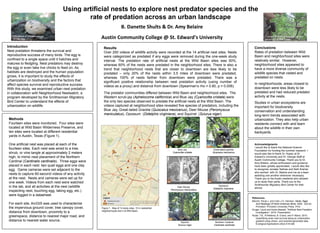
Shults_Summer Research_6202016_FINAL
- 1. Methods Fourteen sites were monitored. Four sites were located at Wild Basin Wilderness Preserve, and ten sites were located at different residential yards in Austin, Texas (Figure 1). One artificial nest was placed at each of the fourteen sites. Each nest was wired to a tree, shrub, or vine tangle at approximately 2 meters high, to mimic nest placement of the Northern Cardinal (Cardinalis cardinalis). Three eggs were placed in each nest: two quail eggs and one clay egg. Game cameras were set adjacent to the nests to capture 60-second videos of any activity at the nest. Nests and cameras were set up for one week. Videos from each nest were watched in the lab, and all activities at the nest (wildlife inspecting nest, touching egg, taking egg, etc.) were logged in a datasheet. For each site, ArcGIS was used to characterize the impervious ground cover, tree canopy cover, distance from downtown, proximity to a greenspace, distance to nearest major road, and distance to nearest water source. Acknowledgments I would like to thank the National Science Foundation for funding the summer research. I would also like to thank Dr. Kopec at St. Edward’s University and Dr. George Staff at Austin Community College. Thank you to Dr. Amy Belaire, whose enthusiasm and guidance have been greatly appreciated. I would also like to recognize Jonatan Salinas and Seth Kramer who worked with Dr. Belaire and me as a team assisting one another whenever necessary. Thank you to the Austin residents who allowed us to study their yards. Thank you to the Smithsonian Migratory Bird Center for their advice. Results Over 250 videos of wildlife activity were recorded at the 14 artificial nest sites. Nests were categorized as predated if any eggs were removed during the one-week study interval. The predation rate of artificial nests at the Wild Basin sites was 50%, whereas 60% of the nests were predated in the neighborhood sites. There is also a trend that neighborhood nests that are closer to downtown are less likely to be predated – only 20% of the nests within 3.5 miles of downtown were predated, whereas 100% of nests farther from downtown were predated. There was a significant positive relationship between nest predation activity (using number of videos as a proxy) and distance from downtown (Spearman’s rho = 0.80, p = 0.006). Conclusions Rates of predation between Wild Basin and neighborhood sites were relatively similar. However, neighborhood sites appeared to have a more diverse community of wildlife species that visited and predated on nests. In neighborhoods, areas closest to downtown were less likely to be predated and had reduced predator activity at the nests. Studies in urban ecosystems are important for biodiversity conservation and understanding long-term trends associated with urbanization. They also help urban residents connect with and learn about the wildlife in their own backyards. B. Danette Shults & Dr. Amy Belaire Austin Community College @ St. Edward's University . Using artificial nests to explore nest predator species and the rate of predation across an urban landscape Introduction Nest predation threatens the survival and reproductive success of many birds. The egg is confined to a single space until it hatches and matures to fledgling. Nest predators may destroy the egg or even take live chicks to feed on. As habitats are destroyed and the human population grows, it is important to study the effects of urbanization on biodiversity and the factors that affect species survival and reproductive success. With this study, we examined urban nest predation in collaboration with Neighborhood Nestwatch, a program developed by the Smithsonian Migratory Bird Center to understand the effects of urbanization on wildlife. Great-tailed grackle Quiscalus mexicanus Blue Jay Cyanocitta cristata Deer Mouse Peromyscus maniculatus Opossum Didelphis virginiana Squirrel Sciurus niger Northern Cardinal Cardinalis cardinalis Figure 1. Map of 14 study sites, 10 in residential neighborhoods and 4 at Wild Basin. References Baicich, Paual J. and Colin J.O. Harrison. Nests, Eggs And Nestlings Of North American Birds. 2005. 2nd ed. Princeton: Princeton University Press. Print. Kruger, Laura and Audra Bassett. "Artificial Nest Predation Investigation". 2016. Presentation. Ryder, T.B., R.Reitsma, B. Evans, and P. Marra. 2010. Quantifying avian nest survival along an urbanization gradient using citizen- and scientist-generated data. Ecological Applications 20(2):419-426. The predator communities differed between Wild Basin and neighborhood sites. The Western scrub-jay (Aphelocoma californica) and Blue Jay (Cyanocitta cristata) were the only two species observed to predate the artificial nests at the Wild Basin. The videos captured at neighborhood sites revealed five species of predators, including the Blue Jay, Great-tailed Grackle (Quiscalus mexicanus), Deer Mouse (Peromyscus maniculatus), Opossum (Didelphis virginiana), and Squirrel (Sciurus niger). Indications of predator activity on clay egg Example of artificial nest and camera placement at Wild Basin
